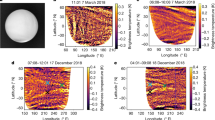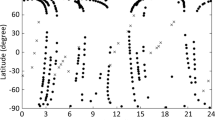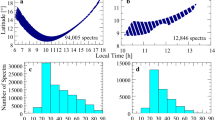Abstract
PIONEER Venus 1 was put into a 24-h orbit around the planet on 4 December 1978. Since then, it has made remote sensing observations of the clouds and the overlying atmosphere at IR, visible and UV wavelengths. The IR instrument includes a channel at a wavelength of 11.5 µm, which is used to measure the effective temperature of the cloud tops. Carbon dioxide, and all of the known constituents of the gaseous atmosphere, are highly transparent at this wavelength. Earth-based telescopic observations at similar wavelengths1–3 have generally shown fairly uniform temperatures of the order of 240 K across the face of Venus. The accepted interpretation has been that the cloud cover on Venus not only covers the whole planet, but is also extremely uniform. The early Pioneer observations confirmed this general picture, for the equatorial and mid-latitudes which comprise most of the surface area of the planet4. Interesting and meteorologically important structure with diurnal, seasonal and random components is found in the Pioneer measurements, as it was in earlier ground-based and spacecraft observations, but this structure has an amplitude of 10 K or less1–6. However, these subtle contrasts which dominate thermal maps of lower latitudes change to dramatic structure near the pole. Even the Earth-based observers, who must view the polar regions on Venus at very oblique angles, have reported cold bands surrounding one or other of the poles at various times2 and occasional polar ‘hot spots’1. The Pioneer orbit passes almost directly over the pole (inclination = 105°) and so provides the first good views of this interesting region. The IR instrument was operated only in its low spatial resolution mode for the first part of the mission. Results from those observations4 showed a wave-shaped collar of high, cold cloud surrounding the north pole, with warmer cloud temperatures polewards. Close to the pole itself, the observed temperature is the highest anywhere on the planet, not only at the cloud top but also in the overlying atmosphere4. We report here the first high data rate, high spatial resolution observations of the polar region. These were obtained on the tenth orbit of Venus on 15 December 1978.
This is a preview of subscription content, access via your institution
Access options
Subscribe to this journal
Receive 51 print issues and online access
$199.00 per year
only $3.90 per issue
Buy this article
- Purchase on Springer Link
- Instant access to full article PDF
Prices may be subject to local taxes which are calculated during checkout
Similar content being viewed by others
References
Murray, B. C., Wildey, R. L. & Westphal, J. A. J. geophys. Res. 68, 4813–4818 (1963).
Diner, D. J., Westphal, J. A. & Schlverb, F. P. Icarus 27, 191–196 (1976).
Apt, J. & Goody, R. Science 203, 785–787 (1979).
Taylor, F. W. et al. Science 203, 779–781 (1979).
Taylor, F. W. J. atmos. Sci. 32, 1101–1105 (1975).
Ksanfomaliti, L. V. et al. Sov. Astr.-AJ. 20, 476–481 (1976).
Murray, B. C. et al. Science 183, 1307–1315 (1974).
Suomi, V. E. & Limaye, S. S. Science 201, 1009–1011 (1978).
Author information
Authors and Affiliations
Rights and permissions
About this article
Cite this article
TAYLOR, F., MCCLEESE, D. & DINER, D. Polar clearing in the Venus clouds observed from the Pioneer Orbiter. Nature 279, 613–614 (1979). https://doi.org/10.1038/279613a0
Received:
Accepted:
Issue Date:
DOI: https://doi.org/10.1038/279613a0
This article is cited by
-
South-polar features on Venus similar to those near the north pole
Nature (2007)
-
Rotation of Venus's polar dipole
Nature (1983)
Comments
By submitting a comment you agree to abide by our Terms and Community Guidelines. If you find something abusive or that does not comply with our terms or guidelines please flag it as inappropriate.



